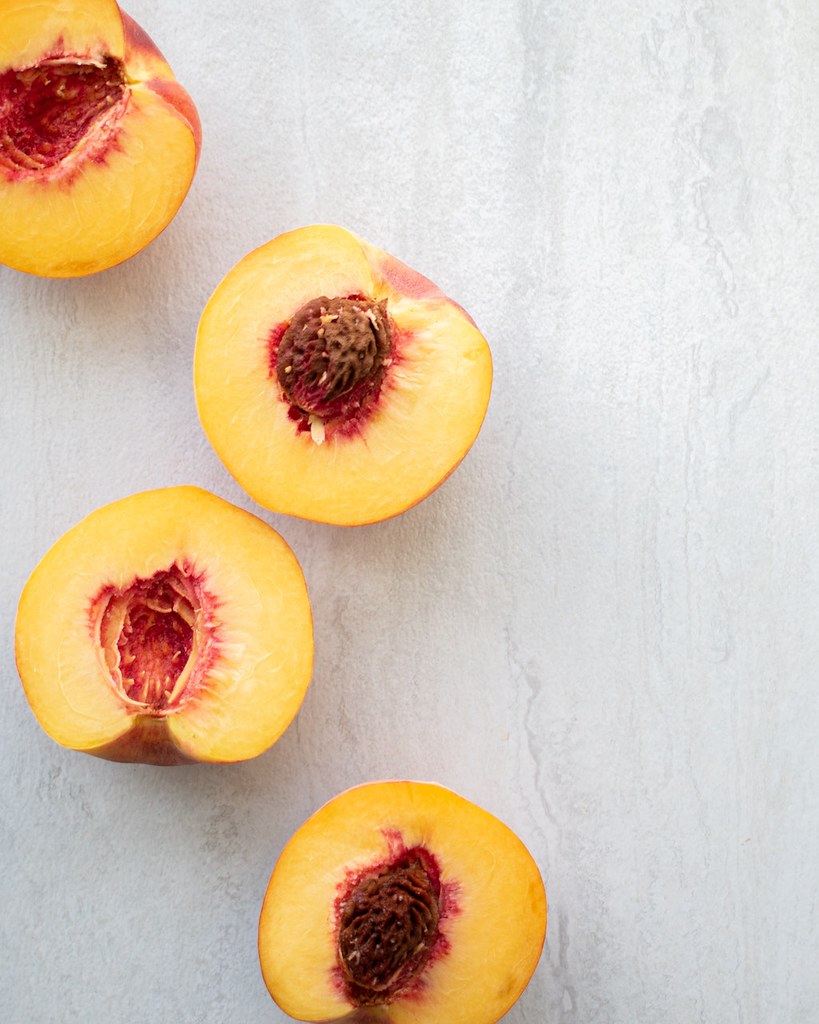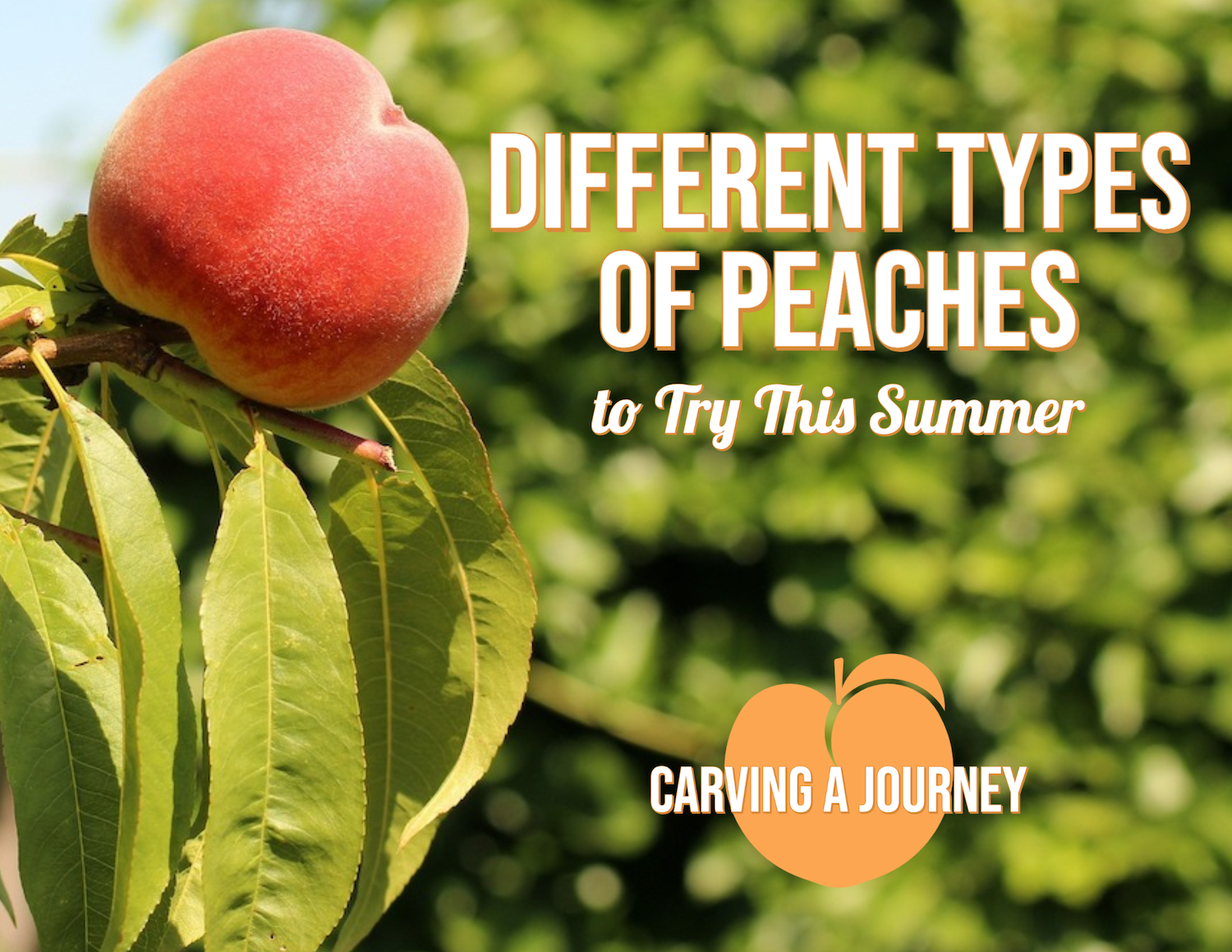This post may contain affiliate links. Please read my disclosure for details at the bottom of this page. As an Amazon Associate, I earn from qualifying purchases on this article about different types of peaches.
Our family loves peaches. During the summer months, we constantly munch on this beautiful and delicious fruit. Some of my favorite peach recipes include our banana peach smoothie and summertime peach Caprese salad. Recently, because we constantly cook with peaches, I became curious about the different peach varieties and how many are available on the market.
I found that, during the summer, in a well-stocked grocery store you can typically find 2 or 3 different types of peaches. But, did you know that there are over 2,000 varieties of this deliciously juicy fruit found across the globe? In the United States alone, there are over 300 varieties! The majority of people never even get to try these different peach varieties because they are not in the grocery store. This information led me to learn more about how to distinguish and choose different varieties of this fruit.
Below, we wanted to list some different distinguishing types of peaches for you to try this summer. These characteristics will help you pick out your peaches!
1. Different Types of Peaches Based On the Pit
When picking out peaches, you first need to know some basic information about the fruit. First, you should think about the pit of the fruit. While most people never think to worry about the pit, you should if you are worried about messiness and convenience!
Peaches are a stone fruit. Just like plums, cherries, and apricots, peaches store their seeds in the pit. Peaches can be categorized based on how the flesh adheres to the stone ‘pit’ at the center. In the end, a peach can belong to one of three categories: Freestone, Clingstone, or Semi-Freestone.

Have You Ever Gone Peach Picking?
Freestone Peaches
When the fruit is ripe, the flesh of a freestone peach can easily tear away and fall from the pit. So, for those wanting a mess-free kitchen, I recommend picking a freestone variety! These fruits take little time to prepare.
Typically, freestone peaches are a bit larger than other varieties and tend to be less sweet and juicy. You can easily slice these or eat them like and apple! Finally, depending on availability, you can get yellow or white varieties of these in supermarkets.
- Common Varieties: Lucky 13, September Snow, Early Amber, Golden Jubilee, Nectar, July Prince
- Harvest Season: You can typically find these in stores from late June through August.
- Uses: I recommend eating these fresh, as well as using them when canning, freezing, and/or baking.
Clingstone Peaches
Certain types of peaches have flesh that sticks to the pit of the fruit. As a result, it can be difficult to remove the flesh from the pit–These types of peaches are known as ‘clingstone peaches.’
Typically, these types of varieties are the first peaches to be harvested at the start of the summer peach season. While difficult to peel, these clingstone varieties are incredibly sweet, soft, and juicy. As a result, they are perfect for jams and blended smoothie recipes.
You can find these peaches in both the yellow and white varieties, though they are often difficult to find in the grocery store. Instead, to find clingstone peaches, look for farmers’ markets and trunks.
When eating clingstone peaches, it is recommended to use a paring knife to remove the flesh rather than eating around the pit.
- Common Varieties: Flordaking, Garnet Beauty, Halford, June Gold, and Ruby Prince, Rich Lady
- Harvest Season: Mid-May to Early June
- Uses: I recommend eating these fresh, as well as using them when making jams, jellies, or baked goods.

Boxes of Beautiful Peaches.
Semi-Freestone Peaches
The semi-freestone peach varieties are a hybrid of the clingstone and freestone peaches. These hybrid peaches give you the best qualities of the other two options!
While this variety is almost as juicy and sweet as clingstone peaches, it also has flesh that can easily be removed from the pit. As a result, you will find many grocery stores carrying these varieties! Actually, nectarines are a variety of semi-free peaches!
- Common Varieties: Florida Prince, Harvester, Coronet, Babcock, Dixie Red, Gold Dust
- Harvest Season: June
- Best Uses: I recommend eating these fresh, as well as using them when making jams, jellies, or baked goods.
2. Different Types of Peaches (Melting and Non-Melting)
A Peach’s flesh can have two types of textures depending on the variety of the fruit. You can have melting and non-melting!
Melting Flesh Varieties
Melting flesh peach varieties ripen incredibly quickly. These peaches have a soft and juice center that melts in your mouth!
Non-Melting Flesh Varieties
While melting flesh peaches tend to ripen and become soft quickly, non-melting peaches remain firm even as they ripen. This type of peach is perfect for canning and preserving!
3. Different Types of Peaches Based On Color
While the exterior of peaches has a multitude of color shades ranging from creamy yellows to maroon red, the interior comes in two colors. When buying peaches, you can either pick peaches with yellow or white flesh.
Yellow Flesh Peaches
Yellow flesh peaches are European and North American peaches with an interior color ranging from bright yellow to orange. Sometimes, depending on the type of peach, the flesh turns a dark red color around the pit. These peaches tend to have more acidity in the flesh compared to the white flesh alternative–this leads the yellow flesh peaches to have a sharper and sweeter flavor.
In the Southern United States, you will see yellow flesh peaches at every grocery store, farmers’ market, and produce stall. If you buy some, try making a peach cobbler!
- Common Varieties: O’Henry, Desert Goldstone, Elberta, Suncrest
- Harvest Season: Mid-to-Late Summer (June through August)
- Best Uses: I recommend eating these fresh, as well as using them when making jams, jellies, or baked goods. Also, I recommend you pair them with cheese and a glass of nice white wine.

Beautiful Yellow Flesh Peaches!
White Flesh Peaches
While yellow flesh peaches are typically grown in Europe and North America, white flesh peaches are primarily grown in Asia. The white flesh varieties have lower acidity and higher sugar content. This means that these taste sweeter and less tart.
- Common Varieties: Snow Angel (Beauty), Aspen White, Polly
- Harvest Season: Early Summer (June)
- Best Uses: I recommend eating these fresh, as well as using them when making jams, jellies, and baked goods. Also, I recommend using them in syrups and specialty cafe drinks.
Finally, if you are curious about nectarines and peaches, I recommend checking out our article ‘Nectarine vs Peach: What Is the Difference?’
We Hope You Enjoyed This List of Different Types of Peaches!
In the end, we hope you enjoyed learning about the different types of peaches to try this summer. If so, let us know in the comment section below. Also, we would love to hear about which varieties you prefer!
If you would like to read more about cooking, you can find further recipes on our blog. We listed some of our favorite Carving A Journey recipes below! For reference, many recipes are influenced by our blended Korean and Southern heritage.
Carving A Journey Korean Recipes:
- Peach Caprese Salad
- Banana Peach Smoothie
- Bibimmyeon (Spicy Korean Cold Noodles)
- Soju Caipirinha (A Korean Take on Brazil’s National Drink)
- Korean Strawberry Milk Recipe
- Brown Sugar Iced Latte (Korean Burnt Sugar Latte); And
- Korean Banana Flavored Milk
If you have any questions or comments, you can also email us at [email protected].
And, finally, we would love to hear from you through our social media as well! You can follow us at @carvingajourney on Instagram, Twitter, Facebook, and Pinterest. Or, if you would like more articles like these, you can subscribe to our blog by joining our mailing list. We hope you enjoyed reading about the different types of peaches! Thank you so much for stopping by!
Carving A Journey is a participant in the Amazon Services LLC Associates Program, an affiliate advertising program designed to provide a means for sites to earn advertising fees by advertising and linking to Amazon.com. Although we may earn commissions for our endorsement, recommendation, testimonial, and/or link to any products or services from this website, these opinions are my own and I fully support these products.

